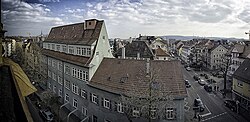Bad Cannstatt
Bad Cannstatt | |
|---|---|
 | |
Location in Stuttgart Urban district | |
| City | Stuttgart |
| Subdivisions | 19 Boroughs |
| Area | |
| • Total | 15.713 km2 (6.067 sq mi) |
| Elevation | 205 m (673 ft) |
| Population (2020-12-31)[1] | |
| • Total | 70,600 |
| • Density | 4,500/km2 (12,000/sq mi) |
| Time zone | UTC+01:00 (CET) |
| • Summer (DST) | UTC+02:00 (CEST) |
| Postal codes | 70331–70378 |
| Dialling codes | 0711 |
| Vehicle registration | S |
| Website | Stuttgart website |
Bad Cannstatt, also called Cannstatt (until July 23, 1933)[2] or Kannstadt (until 1900), is one of the outer stadtbezirke, or city boroughs, of Stuttgart in Baden-Württemberg, Germany. Bad Cannstatt is the oldest and most populous of Stuttgart's boroughs, and one of the most historically significant towns in the area of Stuttgart.[a] The town is home to the Cannstatter Wasen and Cannstatter Volksfest beer festivals, the MHPArena (VfB Stuttgart), the Hanns-Martin-Schleyer-Halle, and the Porsche-Arena.
Name
Bad Cannstatt's name originates from a Castra stativa, Cannstatt Castrum, the massive Roman Castra that was erected on the hilly ridge in AD 90 to protect the valuable river crossing and local trade.[4][5] In the past, Bad Cannstatt has been known as simply Cannstatt or Kannstatt,[6] Cannstadt, Canstatt, Kanstatt, and Condistat.[7] Its name was changed to include "Bad" (German: Bath) to mention the town's spas on 23 July 1933.
History
Bad Cannstatt lies on the Neckar at the convergence of various regional trails.[7] The area was inhabited by the Seelberg mammoth hunters during the
In 746
Cannstatt was the capital of the
In the 19th century, it boasted an attractive town hall, a royal theater, a market house, the
Of the 19 surviving mineral springs, 11 are recognized as state wells.[clarification needed] In the world, it is now second to only Újbuda in Budapest, Hungary, in scale.[12] The Mombach spring is the only one that releases its water without pressure in large quantities; its outflow is used in the adjacent baths and the Wilhelma spa.[citation needed]
Famous Residents
Famous people associated with Bad-Cannstatt include:
- Daimler-Benz. (Karl Benz independently invented a successful automobile in the same year, 96 km away in Ladenburg.)
- Emy Gordon (née von Beulwitz), a writer, translator and Catholic activist
Notes
Citations
- ^ "Aktuelle Einwohnerzahlen nach Stadtbezirken und Stadtteilen". Landeshauptstadt Stuttgart. Retrieved 22 September 2021.
- ISBN 978-3-00-022904-6.
- ^ "The History of Stuttgart". worldtravelguide.net. World Travel Guide.
- ^ "Stuttgart (Germany)". Encyclopædia Britannica. 2009.
- ^ "Early history of Stuttgart". en.driveline-online.de. driveLINE.
- ^ a b c d e f g EB (1911).
- ^ a b c d e f g EB (1878), p. 26.
- S2CID 162201053.
- OCLC 1021410363.)
{{cite book}}: CS1 maint: location missing publisher (link - ^ EB (1878), p. 27.
- ^ "Daimler at a glance". Daimler. Retrieved 25 January 2020.
- ^ "Wissenswertes", Stuttgart Rallye.
Footnotes
References
- Baynes, T. S., ed. (1878), , Encyclopædia Britannica, vol. 5 (9th ed.), New York: Charles Scribner's Sons, pp. 26–27.
- Chisholm, Hugh, ed. (1911), , Encyclopædia Britannica, vol. 5 (11th ed.), Cambridge University Press, p. 189.


